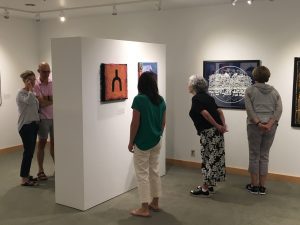Mezuzah Musings – A Weekly Letter From Rabbi Davis – August 3, 2018
Shalom Chaverim,
Over the course of the past year, I had the privilege of teaching a group of talented artists. It was the sixth year of the Minneapolis Jewish Artists’ Lab, this time under the auspices of the The Well and the Sabes JCC. The Artists’ Lab provides an opportunity for artists to explore Jewish tradition while building a stronger arts community. We are one of six cities in the Midwest to have such a program and participants have loved the experience.
 This year, the theme of our studies was Thresholds. Once a month, we gathered in the Learning Center to explore the topic. We considered a variety of thresholds, physical and metaphorical: the gates of Jerusalem, twilight (which stands at the threshold of a new day), transition points in our lives, heat thresholds, etc. Inspired by our learning, each of the artists created a new piece of art all of which are on display in the Tychman-Shapiro Gallery. The exhibition is called, Crossing the Threshold and runs until August 23.
This year, the theme of our studies was Thresholds. Once a month, we gathered in the Learning Center to explore the topic. We considered a variety of thresholds, physical and metaphorical: the gates of Jerusalem, twilight (which stands at the threshold of a new day), transition points in our lives, heat thresholds, etc. Inspired by our learning, each of the artists created a new piece of art all of which are on display in the Tychman-Shapiro Gallery. The exhibition is called, Crossing the Threshold and runs until August 23.
Fittingly, we encounter the idea of thresholds in last week’s and again in this week’s parasha: “write them on the doorposts of your house and on your gates.” We are familiar with the mitzvah of mezuzah. We appreciate the way artists have beautified the mitzvah making mezuzot out of silver, ceramic, glass, wood, even Legos! But what is the true significance of this ritual object?
We associate mezuzot with permanent dwelling places. A sukkah or a tent does not require a mezuzah. Indeed, the halakha is that only when one resides longer than 30 days in a home are they obligated to affix a mezuzah. But upon further consideration, mezuzot may be less about our lodgings and more about our wanderings.
Mezuzot are davka placed on doorways and gates to mark our comings and our goings. In fact, some say the word mezuzah itself is based on the Hebrew root zuz, to move, and that it is slanted to the left to represent the movement of a person’s shoulders and arms as they walk.
Marc Alain-Ouaknin, a modern French Jewish thinker, explains it this way in his book, Jewish Symbols: “To be a pagan is to fix oneself somewhere, fix oneself to the ground to a certain extent, establish oneself through a pact with permanency which authorizes the sojourn and certifies the certitude of territory. Being on the way, being nomadic is a response to a way of being which possession does not satisfy. To put oneself on the way, is already the meaning of the words heard by Abraham, ‘Leave your birthplace, your kin, your home.’ It is important to leave one’s home, to come and to go as a way of affirming that life is in fact a journey. And this is the message of the mezuzah.”
As Jews, we have followed in Abraham’s footsteps and have been a wandering people. We have left our homes, left possessions behind and set out on our way. By force and by choice, we have learned that life is a journey. But Alain-Ouaknin is not only speaking in the literal sense: “Affixed to the doorpost of a home, the mezuzah is a reminder to man that he has come a long way, but that the voyage does not end here, and that he must continue to reinvent himself.” In other words, at the metaphoric thresholds of our lives, the mezuzah calls out: “go” and “grow.”
The artists in the Lab have taken this message to heart as they explore new texts and new techniques.
May each of us in our own comings and goings be blessed on our journey.
L’Shalom,
Rabbi Alexander Davis
adavis@bethelsynagogue.org
